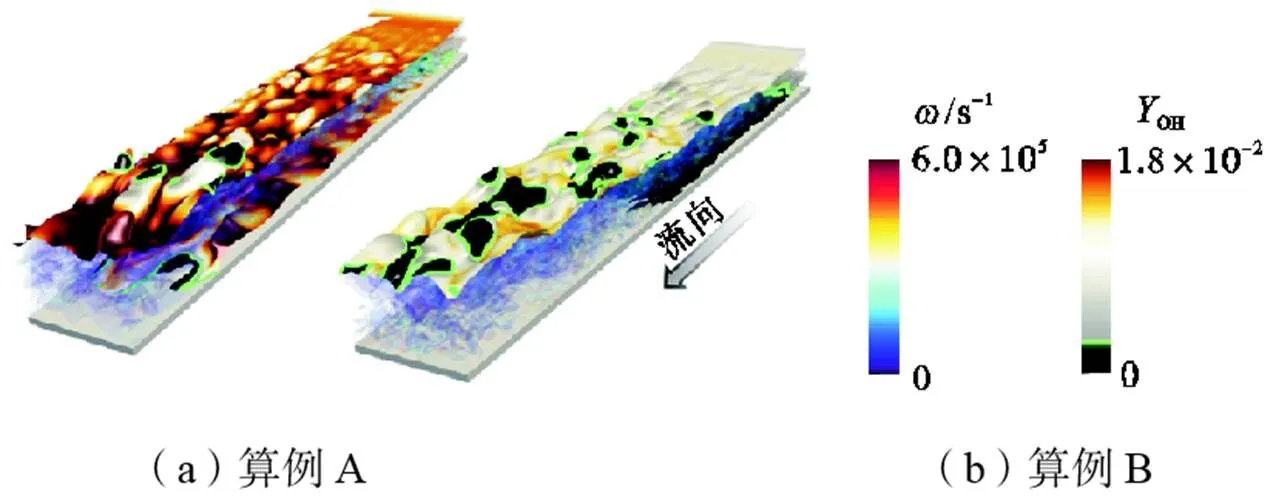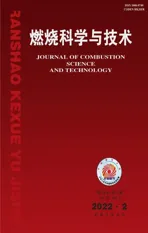湍流非预混射流火焰倾斜冲击壁面的直接数值模拟研究
2022-04-26王海鸥樊建人
陈 果,王海鸥,罗 坤,樊建人
湍流非预混射流火焰倾斜冲击壁面的直接数值模拟研究
陈 果,王海鸥,罗 坤,樊建人
(浙江大学能源清洁利用国家重点实验室,杭州 310027)
采用直接数值模拟方法,选取17组分、73步简化的甲烷化学反应机理,对三维湍流平面甲烷射流火焰倾斜冲击壁面进行了研究. 分析了相同湍流强度、不同Damköhler数的两个算例. 两个算例出现了不同程度的熄火,算例B的熄火现象比算例A更明显. 同时,观察到当量混合分数等值面的凸起结构与火焰熄火现象存在一定关联. 定量分析了火焰面平均曲率与熄火的相关性,发现在剪切流动中熄火区域的平均曲率大于燃烧区域的平均曲率;在壁面附近的熄火区域曲率的大小与壁面熄火模式相关.
直接数值模拟;熄火;曲率
为了运行的安全性和稳定性,大多工业燃烧装置采用非预混燃烧技术.燃料/氧化剂的快速混合速率可以促进燃烧,但过快的湍流混合会导致熄火[1-5],增加燃烧室未燃碳氢化合物等污染物排放.同时,在有限空间的燃烧室中,火焰与壁面的相互作用无法避免,出现壁面熄火,影响燃烧效率和污染物排放特性.因此,研究非预混湍流燃烧/壁面相互作用过程中的熄火现象具有重要的工程应用价值.
研究湍流非预混火焰中熄火问题的手段主要有实验测量和数值模拟.在实验方面,Takahashi等[6]采用Mie散射/细丝测温法和双色示踪粒子测速仪(PIV)的方法,对湍流甲烷射流扩散火焰进行测量,研究了涡-火焰相互作用以及相互作用发生后的局部熄火,发现火焰面在涡结构的作用下发生凸起,火焰在涡结构的作用下发生了局部熄火.Lyons等[7]采用激光诱导CH基荧光(CH-PLIF)与颗粒成像测速技术测量了甲烷/空气扩散火焰,其用CH基的分布来辨识火焰的熄火现象,发现火焰面的凸起是火焰熄灭前会发生的事件之一.然而,由于实验测量技术的局限性,往往采用的是二维的测量手段,且测量的物理量有限,仅能测量如组分浓度、速度等物理量.而与熄火有关的物理量,如标量耗散率、应变率、曲率等在测量中难以直接获取.
近来,与非预混燃烧熄火问题有关的数值模拟研究受到广泛关注,尤其是随着高性能计算领域的蓬勃发展,许多学者开始采用高精度的直接数值模拟(DNS)方法来研究这一问题.在以往的非预混射流火焰的DNS研究中,发现了当量比混合分数等值面上出现的熄火区域,处于火焰面由燃料向氧化剂凸起的结构上[8-11].Wang等[10]通过湍流火焰边缘的拓扑结构特征,分析了非预混火焰的熄火和再燃;观察到熄火区域一般是以氧化剂为曲率中心的负曲率,而燃烧区域是正曲率;还发现了负曲率的熄火区域处热释放率低,而在正曲率的燃烧区域热释放率高.Karami等[1]实现了空间发展的三维湍流射流抬升非预混火焰的DNS,用当量混合位置处的产物的质量分数的临界值来判定是否熄火,并以此依据来追踪识别熄火区域的面积变化规律.发现熄火区域的面积增长由切向应变率主导,而熄火区域的愈合过程受到曲率和标量耗散率的共同作用.
在上述工作中,前人通过实验与模拟等手段对非预混火焰面的凸起与熄火现象进行了研究.但是,在工程实际问题中,存在很多火焰-壁面相互作用的场景.这种场景下的关于非预混火焰面凸起与熄火的研究在国内外还未见报道.为填补该研究的空白,笔者最近对甲烷燃料平面射流非预混火焰倾斜冲击壁面进行了直接数值模拟研究[12-13],本文对其中的火焰面凸起和熄火现象进行了深入研究,分析得出了在壁面存在的场景下非预混火焰曲率与熄火现象之间的关联.
1 数值方法和算例设置
1.1 数值模拟方法
直接数值模拟求解全可压反应流的Navies-Stokes方程组.控制方程采用4阶显式龙格-库塔格式进行时间推进,8阶中心差分格式作为空间离散,并采用10阶过滤以消除高频的数值震荡偏差.化学组分的热物性参数和扩散系数在该程序中采用多项式插值的方式来拟合.
选取17组分、73步的甲烷/空气燃烧的简化机理,另外4种组分(CH2、CH2(S)、HCO和CH2OH)为准稳态机理组分.该机理由GRI-1.2骨架机理简化而来.使用CHEMKIN程序[14]中的稳态对冲火焰对该机理进行验证,发现该机理与详细化学反应甲烷机理、GRI-3.0骨架机理等所得出的甲烷燃烧结果十分接近,因此采用该机理来进行直接数值模拟计算是可行的.
1.2 算例设置


图1 计算工况示意




表1 来流的组分浓度

Tab.1 Concentration of species in incoming flow
2 结果与讨论
2.1 火焰面凸起与熄火现象
从图2可以看出湍流使得火焰面褶皱,其中用OH质量分数的大小着色,熄火区域为黑色,射流中心为渲染的涡量.在算例A的上分支火焰,湍流作用于火焰面产生凸起.凸起位置处OH的值较小.随着湍流的发展,在下游的位置,凸起的位置处发生了熄火.类似的现象在算例B中也存在.在乙烯/氧气非预混火焰的直接数值模拟研究中,Lignell等[2]也观察到在当量混合分数等值面上熄火现象与火焰面凸起有关.

图2 算例A和算例B的当量混合分数等值面
2.2 火焰面曲率

2.3 火焰面曲率在熄火与燃烧区域的统计

图3 归一化的曲率在x-y平面上的云图


图4 算例A和算例B中燃烧/熄灭的火焰面上的归一化曲率沿流向的分布


图5 近壁面当量混合分数等值面与火焰面熄火示意

图6(c)是算例B的上分支火焰在中游(/位于20~30)和下游(/位于30~40)燃烧/熄火区域的平均曲率的PDF.可以看出,熄火区域曲率的值大于燃烧区域,且下游的曲率略大于中游,这与图6(a)的算例A上分支火焰中的规律完全一致.对于下分支火焰,由于算例B在入口倾斜段就已完全熄灭,因此图6(d)只有入口倾斜段的燃烧/熄灭区域而没有近壁面区域的PDF统计,从中可以看出熄火区域的曲率大于燃烧区域,这与图6(b)中算例A下分支火焰倾斜段的曲率分布规律一致.

图6 不同流向位置、燃烧/熄火区域的曲率的PDF
3 结 论
本文对湍流平面射流火焰倾斜冲击壁面进行了直接数值模拟研究.设置了两组Damköhler数不同而射流Reynolds数相同的算例,在两组算例中,火焰的熄火程度不同,算例B的熄火比算例A严重.在两个算例中都观察到,熄火区域与火焰凸起存在关联性,通过定量地分析火焰面的曲率,发现除了壁面熄火的区域以外,在其他位置的火焰面,熄火区域的曲率大于燃烧区域,而壁面熄火区域出现了负的曲率.此外,还发现随着射流火焰的发展,湍流在下游衰减,湍流尺度增大,火焰面曲率减小.
[1] Karami S,Talei M,Hawkes E R,et al. Local extinction and reignition mechanism in a turbulent lifted flame:A direct numerical simulation study[J].,2017,36(2):1685-1692.
[2] Lignell D O,Chen J H,Schmutz H A. Effects of Damköhler number on flame extinction and reignition in turbulent non-premixed flames using DNS[J].,2011,158(5):949-963.
[3] Karami S,Hawkes E R,Talei M,et al. Mechanisms of flame stabilisation at low lifted height in a turbulent lifted slot-jet flame[J].,2015,777:633-689.
[4] Pantano C. Direct simulation of non-premixed flame extinction in a methane-air jet with reduced chemistry [J].,2004,514:231-270.
[5] Hawkes E R,Sankaran R,Sutherland J C,et al. Scalar mixing in direct numerical simulations of temporally evolving plane jet flames with skeletal CO/H2kinetics[J].,2007,31(1):1633-1640.
[6] Takahashi F,Schmoll W J,Trump D D,et al. Vortex-flame interactions and extinction in turbulent jet diffusion flames[J].(),1996,26(1):145-152.
[7] Lyons K M,Watson K A,Carter C D,et al. On flame holes and local extinction in lifted-jet diffusion flames[J].,2005,142(3):308-313.
[8] Hawkes E R,Sankaran R,Chen J H. Reignition dynamics in massively parallel direct numerical simulations of CO/H2jet flames[C]//16. Australia,2007:1271-1274.
[9] Hawkes E,Sankaran R,Chen J. A study of extinction and reignition dynamics in syngas jet flames using terascale direct numerical simulations:Sensitivity to the choice of reacting scalar[C]//. Australia,2007:46-49.
[10] Wang L,Hawkes E R,Chen J H. Flame edge statistics in turbulent combustion[J].,2011,33(1):1439-1446.
[11] Karami S,Talei M,Hawkes E R,et al. Local extinction and reignition mechanism in a turbulent lifted flame:A direct numerical simulation study[J].,2017,36(2):1685-1692.
[12] Wang H,Chen G,Luo K,et al. Turbulence/flame/ wall interactions in non-premixed inclined slot-jet flames impinging at a wall using direct numerical simulation[J].,2021,38(2):2711-2720.
[13] Chen G,Wang H,Luo K,et al. Flame edge structures and dynamics in planar turbulent non-premixed inclined slot-jet flames impinging at a wall[J].,2021,920:A43.
[14] Kee R J,Rupley F M,Miller J A. CHEMKIN-III:A FORTRAN Chemical Kinetics Package for the Analysis of Gas-Phase Chemical and Plasma Kinetics[R]. USA:Sandia National Laboratory,1996.
[15] Bilger R W. The structure of diffusion flames[J].,1976,13(1-6):155-170.
[16] Passot T,Pouquet A. Numerical simulation of compressible homogeneous flows in the turbulent regime[J].,1987,181:441-466.
[17] Pitsch H,Bollig M. FlameMaster v3.3.10,a C++ Computer Program for 0d Combustion and 1d Laminar Flame Calculations[Z]. 2015.
Study of Turbulent Non-Premixed Slot-Jet Flame Obliquely Impinging at Flat Wall Using Direct Numerical Simulation
Chen Guo,Wang Haiou,Luo Kun,Fan Jianren
(State Key Laboratory of Clean Energy Utilization,Zhejiang University,Hangzhou 310027,China)
In this paper, the three-dimensional turbulent planar methane slot-jet flame obliquely impinging at a wall was simulated using direct numerical simulation (DNS), in which a 17-species 73-step reduced mechanism for methane chemical reaction was selected. Two cases (A and B) with the same turbulence intensity but different Damköhler numbers were analyzed. It was observed that the extinction of different degrees occurred in both cases, and the extinction event in Case B was more significant than that in Case A. Meanwhile, the flame extinction event was correlated to the bulge structure on the stoichiometric mixture fraction iso-surface. The correlation between the mean curvature of the flame surface and the extinction event was quantitatively analyzed, and it was found that in the shear layers, the value of mean curvature in the extinction regions was larger than that in the burning regions. In addition, this value in the near-wall extinction region was correlated to the extinction mode.
direct numerical simulation;extinction;curvature
TK16
A
1006-8740(2022)02-0157-06
10.11715/rskxjs.R202202019
2021-04-15.
国家自然科学基金资助项目(51836007).
陈 果(1996— ),男,博士研究生,guo_chen@zju.edu.cn.
王海鸥,男,博士,研究员,wanghaiou@zju.edu.cn.
(责任编辑:武立有)
